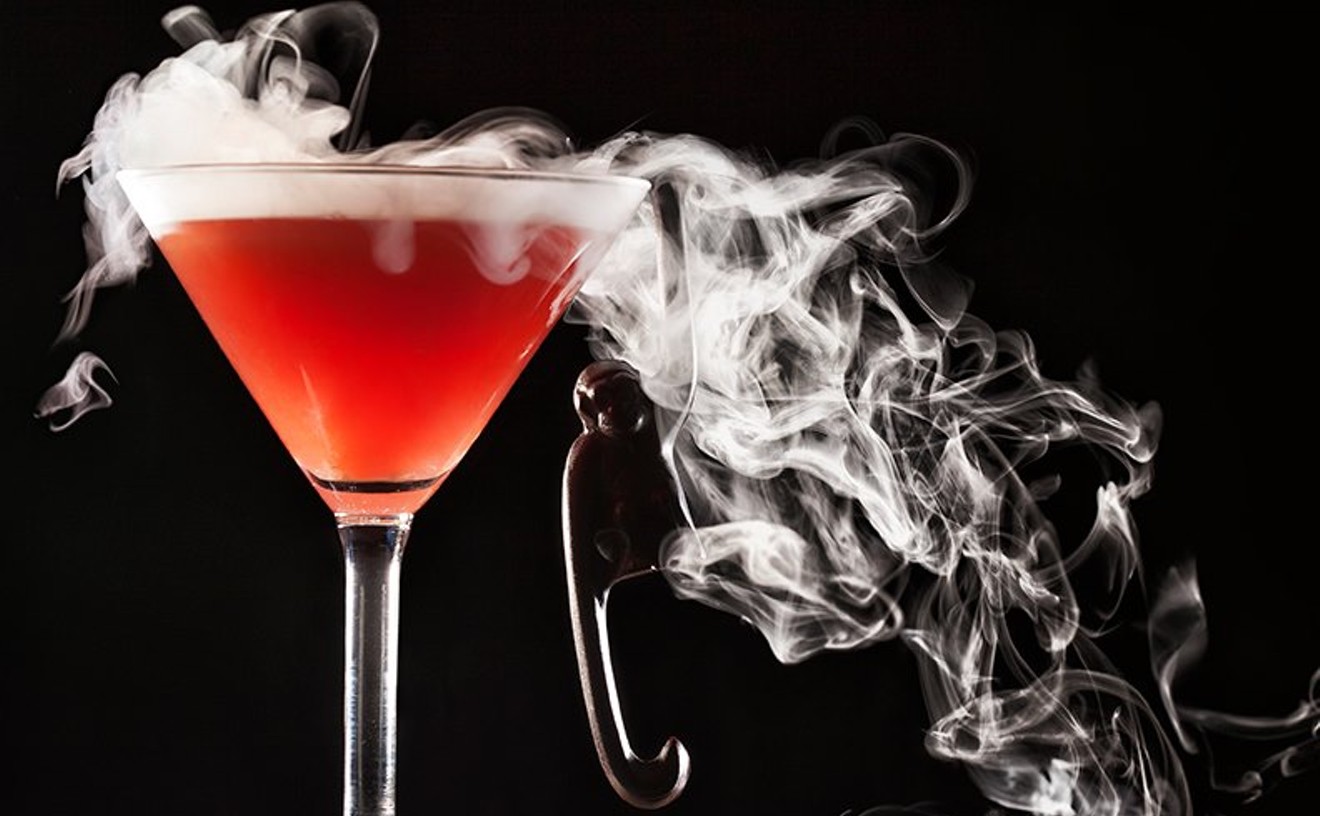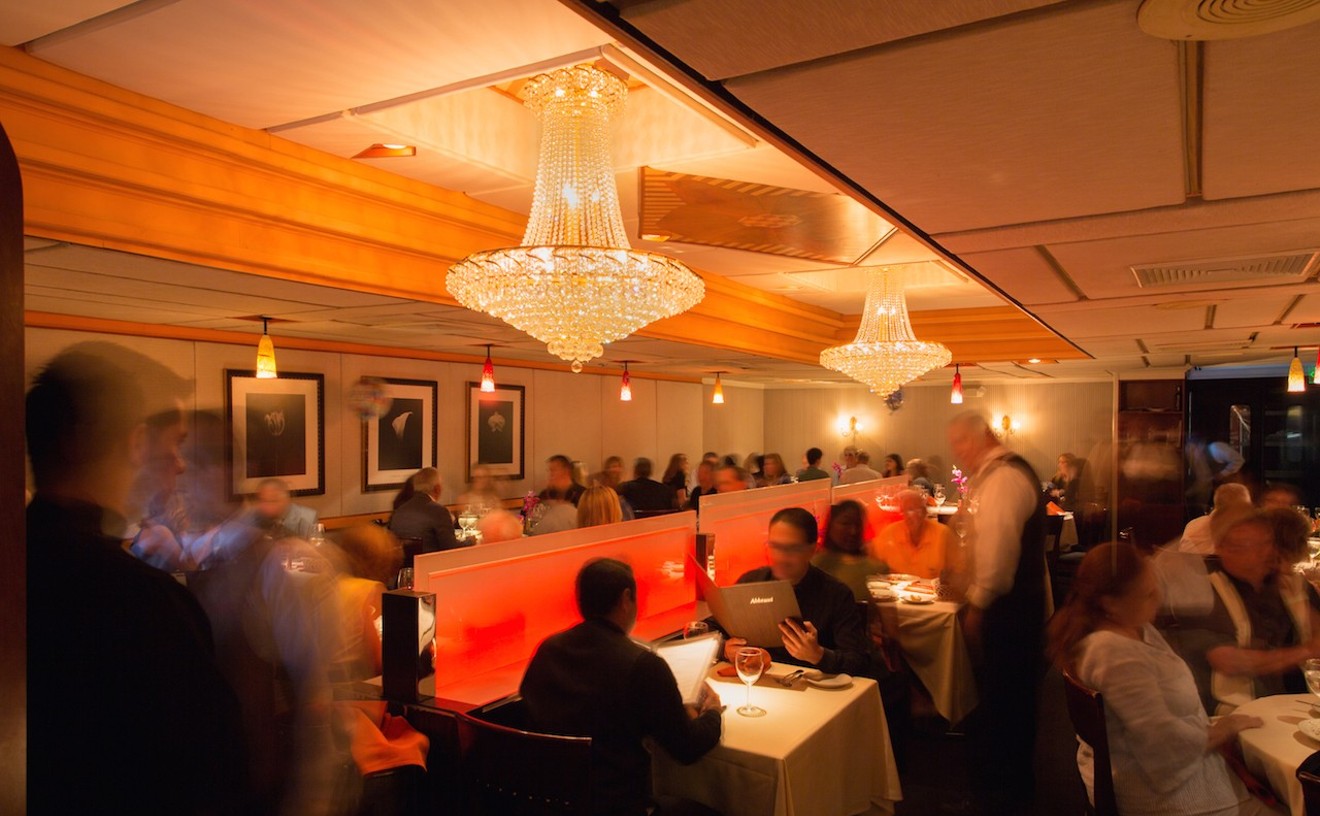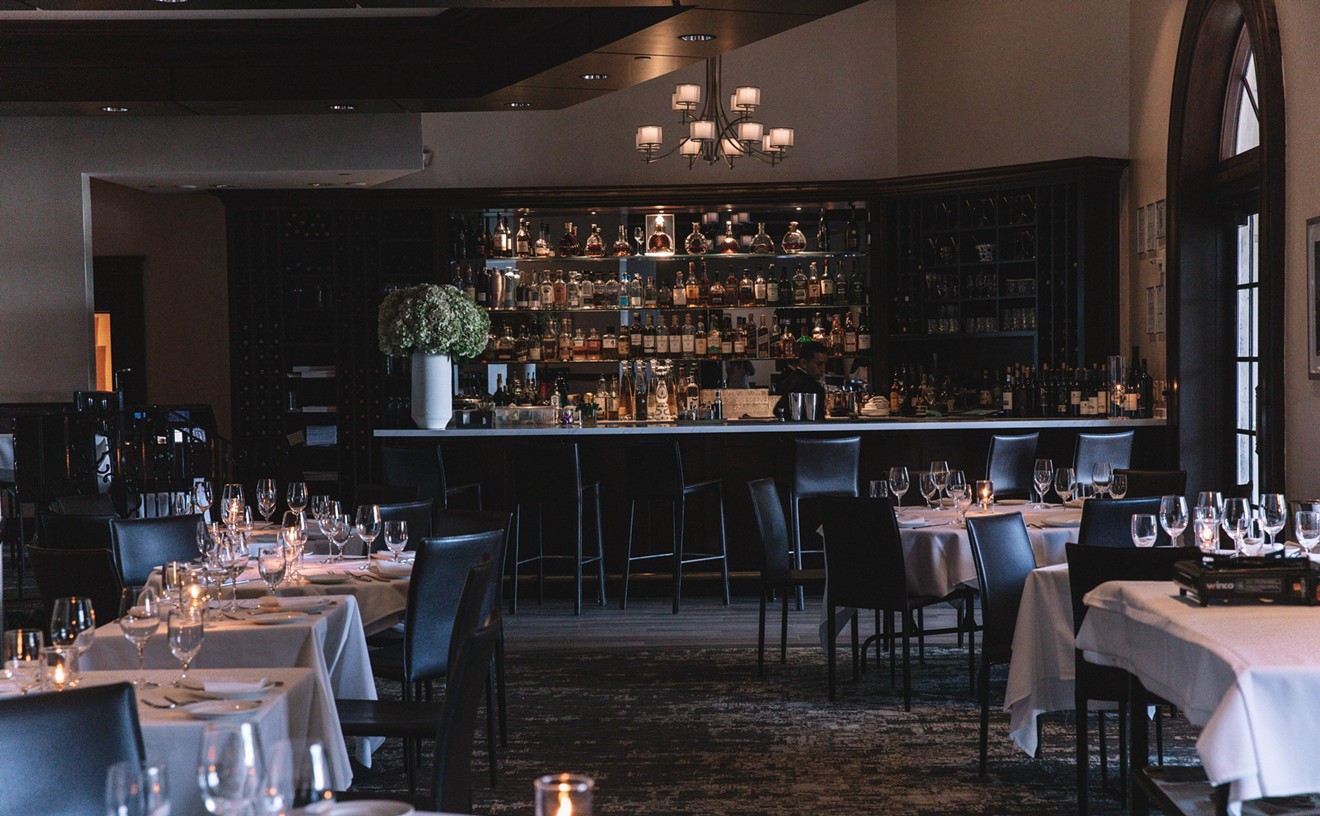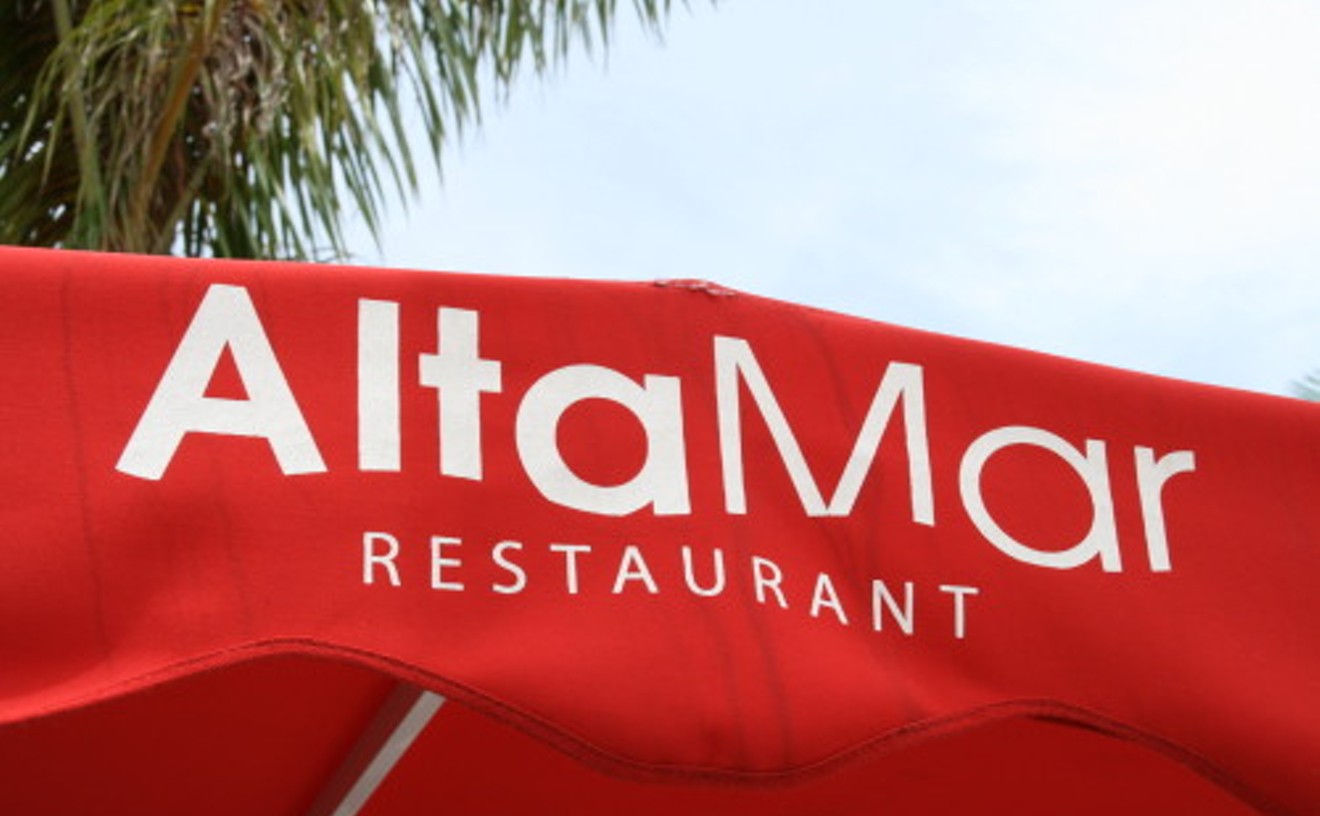Best Restaurateur
Barton G. Weiss

Max Shapovalov
Don't let the live giraffes, cryogenic nitro-martinis, and dumbfounding desserts such as the "chocolate fun-do fountain" gurgling with four pounds of Belgian dark distract you from seeing the serious genius of Mr. Barton G. He was already known as Miami's most outlandishly creative caterer by the time he opened his namesake South Beach restaurant in 2002. The sophisticated eatery with the whimsical presentation was way ahead of its time back then and continues to keep the new concepts coming. This past year, Weiss showed a peerless ability to provide classy, elegant dining when he opened Prelude in the Adrienne Arsht Center and Villa at the former Versace mansion. Yet what cements Barton's reputation as being a cut above the rest is his bucking of the common practice of charging exorbitant prices on New Year's Eve; Prelude served the same pre-theater $39 prix fixe dinner menu as always, refusing to exploit the restaurant patio's view of the Bayside fireworks. By the way: This is one of the best dinner deals around even when it's not New Year's Eve. Vision, value, and damn good food. What more could you want from a restaurateur?
- 1427 W. Ave., Miami Beach, 33139 Map
- 305-672-8881
- bartong.com
Best Chefs
Jonathan Eismann and Dewey LoSasso
Past winners of our annual lifetime achievement type of award (where seniority counts!): Van Aken, Militello, Susser, Oudin, Ruiz, Bernstein, Schwartz, Rodriguez, and Hutson. It is time to etch Eismann and LoSasso into our Rushmore of pioneering Miami chefs. Jonathan Eismann introduced pan-Asian cooking and spearheaded fine dining on Lincoln Road when he opened Pacific Time in 1993; back then, there was nothing fine about the pedestrian mall. Next, Eismann leapt into the Design District with more globally inspired PT2 — and leapt some more with PizzaVolante, Q American Barbeque, and Fin seafood joint, all in the same neighborhood. The man ain't slowing down. Nor is Dewey LoSasso, who first impressed at the Foundlings Club during the early '80s. He was opening executive chef of Tuscan Steak and really hit his stride when he and wife Dale opened North One 10 in 2004. He, as well as Eismann, recognized early the importance of a place-of-your-own to pursue a personal culinary vision — his was the use of quality local ingredients, which he turned into fresh, creative, delectable American fare. After the locally loved but economically unsuccessful establishment closed, LoSasso took a consolation prize and secured one of the most sought-after chef gigs: helming the landmark Forge as it reopened in its gloriously renovated return. The renewed attention these comeback chefs have received is enough to make one believe that dedication, talent, and integrity really do prevail.
Best Restaurant Host
Nino Pernetti

Photo by Ana Adams
Nino Pernetti's life story includes growing up in postwar Venice, Italy; training at a prestigious hotel school; cooking across four continents; and taking trips to Kabul, Caracas, Singapore, Kuala Lumpur — well, a lot of places. But you needn't know that, or the fact that he serves on more boards than Dwyane Wade — Make-A-Wish Foundation, Jackson Memorial Foundation, Florida Concert Association, and so forth — to appreciate the skillful orchestration he exhibits at his landmark Coral Gables restaurant, Caffè Abbracci. No doubt the consistently mouthwatering renditions of quintessential Italian cuisine — and the best tiramisu either side of Kalamazoo — have played a big part in Abbracci's success. But dining isn't all about what's on the plate. While overseeing his top-flight professional service staff, Pernetti makes customers feel at home with his effervescent charm and hospitality. Old-timers are treated like family, and new-timers are treated like old-timers — before inevitably becoming such. That's how Caffè Abbracci has kept its tables filled for more than 20 years.
- 318 Aragon Ave., Coral Gables, 33134 Map
- 305-441-0700
- www.caffeabbracci.com
Best Restaurant Decor
STK Miami

Courtesy of STK
Located just off the Gansevoort lobby, STK Miami practically glistens with big-city allure. Like the original in Manhattan's Meatpacking District, this lofty, two-story steak house boasts an industrial-chic warehouse look, but with a dash of decidedly South Beach style. Celebrated design team ICRAVE uses a muted palette of textures such as wood, marble, mirrors, glass, suede, stone, and white brick, each illuminated by a varied, multihued lighting system. The effect is soft and sensual yet dramatic — and a welcome change from the tired white whimsical look that has so long defined hotel restaurant design in these parts. The main floor serves as both dining room for STK and home to Coco De Ville, a 2,000-square-foot lounge streaked with white ottomans. The second floor houses a bar, a private dining area, and restaurant seating that overlooks the action below — as does a staircase/catwalk that customers use to ascend and descend. You won't find a prettier crowd to peer down upon. Of course, all of ICRAVE's attention to detail will have been for naught if you don't lift your eyes from the fat, juicy steak sitting in front of you on the table. Which isn't so easy to do.
- 2305 Collins Ave., Miami Beach, 33139 Map
Best Expensive Italian Restaurant
Il Mulino

Il Mulino New York - Miami
Hey there, Mr. I-Used-to-Have-a-Bottomless-Expense-Account. Back then, you would breeze into Il Mulino like a big shot, thumb through the wine list, and choose one of the vintage reserves. Lucky for you, there are bottles starting a bit below $50. Plus you'll still have your classic Manhattan cocktail — for chrissakes, a man's gotta live. And if you're polite, there's a good chance you'll be served a free glass of green apple-infused grappa after your meal. Listen: Sacrifices have to be made, your mindset must be adjusted. (Hint: Take advantage of all the complimentary antipasti, garlic bread, and focaccia piled in front of you before dinner.) But you don't have to give up the larger-than-life flavors found in Mulino's jumbo prawns from Sardinia, in the Dijon-crusted rack of lamb, in the homemade cannelloni stuffed with veal, lamb, and beef. You needn't part with your beloved chicken parmigiana, whose pounded European breast is smothered in Old World marinara sauce, or — God forbid — the signature veal osso buco with porcini mushrooms served over flawless saffron risotto. If anything, dining at Il Mulino and gazing at the stunning ocean vista will keep you from dwelling on pressing problems — like who are those people in the black van parked across from your house anyway? Sure, a tenderloin steak the size of a cattleman's fist or a whole imported branzino fish might cost more than $50, but there are plenty of choices in the $28 to $38 range. Keep your chin up, Mr. Down-But-Not-Out, and be thankful Il Mulino is a luxury you can still afford. You just have to start living with the idea of not doing so every night.
- 17875 Collins Ave., Sunny Isles Beach, 33160 Map
- 305-466-9191
- www.imny.com/location/miami
Best Inexpensive Italian Restaurant
Spiga

Italian restaurants come and go. And come and go. And come and go. Some boast prime location; some tout wood-burning ovens, early-bird specials, happy hours, and karaoke nights. Spiga doesn't go in for a whole lot of razzmatazz. Located in the boutique Hotel Impala, the cozy, romantic restaurant is aglow in low light and awash in rich wood; the porch is one of the most charming spots for alfresco dining the city has to offer. The cuisine is handsome and humble too — fresh ingredients forged into our favorite Northern Italian classics. Grilled calamari with olive oil and lemon, red snapper alla Livornese, a signature seafood soup brimming with shellfish, and veal scaloppine with prosciutto and sage are just a few of the simple and simply delicious dishes. But Spiga especially shines when it comes to homemade pastas. Gnocchi is ethereally light, ravioli is sumptuously soft, and quadretti with portobello mushrooms, truffle oil, and shaved Parmesan exemplifies Italian cooking at its flavor-exploding best. All pastas are under $20, most starters less than $10, and there's a wide selection of well-priced wines. Desserts — including the finest ricotta cheesecake you'll encounter south of Mulberry Street — are $8. Perhaps most important, first-timers here are treated like regulars. Maybe that's why Spiga has been going strong, in fickle South Beach, for 15 years.
- 1228 Collins Ave., Miami Beach, 33139 Map
- 305-534-0079
- www.spigarestaurant.com
Best Pizza Joint
Pizza Volante
Jonathan Eismann evidently took the famous exhortation "Go West, young man!" to mean the west side of Miami's Design District (plus he waited until he wasn't all that young). Eismann charged into the fledgling neighborhood with his flagship Pacific Time and has recently added the new duo of Q and Fin. But perhaps his most heralded pioneering effort came when PizzaVolante led the parade of gourmet pizza joints that ended up settling in this town. The look is industrial cool, with marble-topped tables and orange Kartell chairs upon polished concrete floors. The thin-crusted pizzas, fired up fresh-to-order in the wood-burning oven, are topped with a bright, slightly sweet tomato sauce and can be crowned with any number of regional mozzarella cheeses — from Campagna bufala to a local cow's milk ovaline — or with vegetables grown in our own Redland and roasted in the wood oven. Pies start at a mere $9 for the Margherita and top out at $16. Plus the wine list features 18 selections for $18 — per bottle, not glass. That is how the west is won.
Best Raw Bar
CJ's Crab Shack

Got a hankering for topnotch seafood and service with a smile while sunning yourself on SoBe's golden shores or perusing shops along Ocean Drive? There's only one place to go. With an extensive menu of sumptuous ocean fare and fair prices that get even better during happy hour, CJ's Crab Shack has something for everyone. Owners Chris and Jori opened the place two years ago on the Fourth of July, and their establishment has maintained that celebratory atmosphere. Good times, good food, and booze abound. Specialty drinks such as "Chris's famous rum punch" and "Jori's soon-to-be-famous margarita" run $9 regularly and just $6 from 4 to 7 p.m. Monday through Friday, with domestics and imports, regularly priced at $5 and $6, dropping to $4. Menu highlights include drunken shrimp ($11.95) — one of Chris's personal faves — steamed in beer and seasoned Cajun-style. The crab dip — with cheese, spinach, and artichoke — overflows with the crustacean for only $11.95 or $6 during happy hour. Or check out the "bucket o' crab": five whole blue crabs in Old Bay for $24.95.
- 600 Ocean Dr., Miami Beach, 33139 Map
- 305-604-5951
- www.cjscrabshack.com
Best Seafood Restaurant
AltaMare

Claudio Giordano's Alta Mar restaurant in South Beach had been an unqualified success since 2002, so it came as a surprise when this past year, he moved the eatery next door, brought in new chef Simon Stojanovic, and even changed the name of the place by adding an e to the end. The current space boasts an open kitchen, chef's table, intimate bar, and private dining rooms. Stojanovic, who learned a thing or two about cooking while working as Michael Schwartz's sous chef, boasts a menu of creatively plated, locally snared seafood (along with sustainable meats and pastas made in-house). Starters include grilled octopus with chorizo, grilled lemon, green tomato, and saffron aioli served over warm farro ($15) — that's a daring juggle of flavors, but Stojanovic keeps them in the air. Entrées are no less captivating: Pan-seared halibut with Swank Farms watercress, Borek Farms heirloom tomatoes, Florida avocados, and arugula vinaigrette not only taste fantastic but also demonstrate an allegiance to local growers. While ingredients are close to home, the culinary style pays homage to the Mediterranean — as in a pan-seared striped sea bass over risotto with sage, pistachios, and Meyer lemon ($29). What was a very good seafood restaurant is now a great one.
- 1233 Lincoln Rd., Miami Beach, 33139 Map
- 305-532-3061
- www.altamarerestaurant.com
Best Fish Sandwich
El Floridita Seafood Restaurant

El Floridita takes you back to a time when life was simple: Men were men, women were women, fish were fish, and fish houses were made of wood and featured fish tanks, raw bars, saloon-style alcohol, and trophy fish on the wall. El Floridita makes fish sandwiches the old-fashion way too — as in tasty, not fancy. First the folks in the kitchen take fresh menudo, which is not the Mexican soup but the Filipino name for the labahita fish. The mild, white-fleshed saltwater species is plunked into a fryer and then inside a wedge of Cuban bread, topped with lettuce, tomato, and onion; tartar sauce comes on the side. It is an ideal example of less being more. Are you old enough to remember when such a sandwich cost $2.50 (or just $1.95 sans the lettuce and tomato)? Ah, those were the days — and still are at El Floridita.
- 8399 Bird Rd., Miami, 33155 Map
- 305-221-1511
- www.elfloriditaseafoodrestaurant.com





